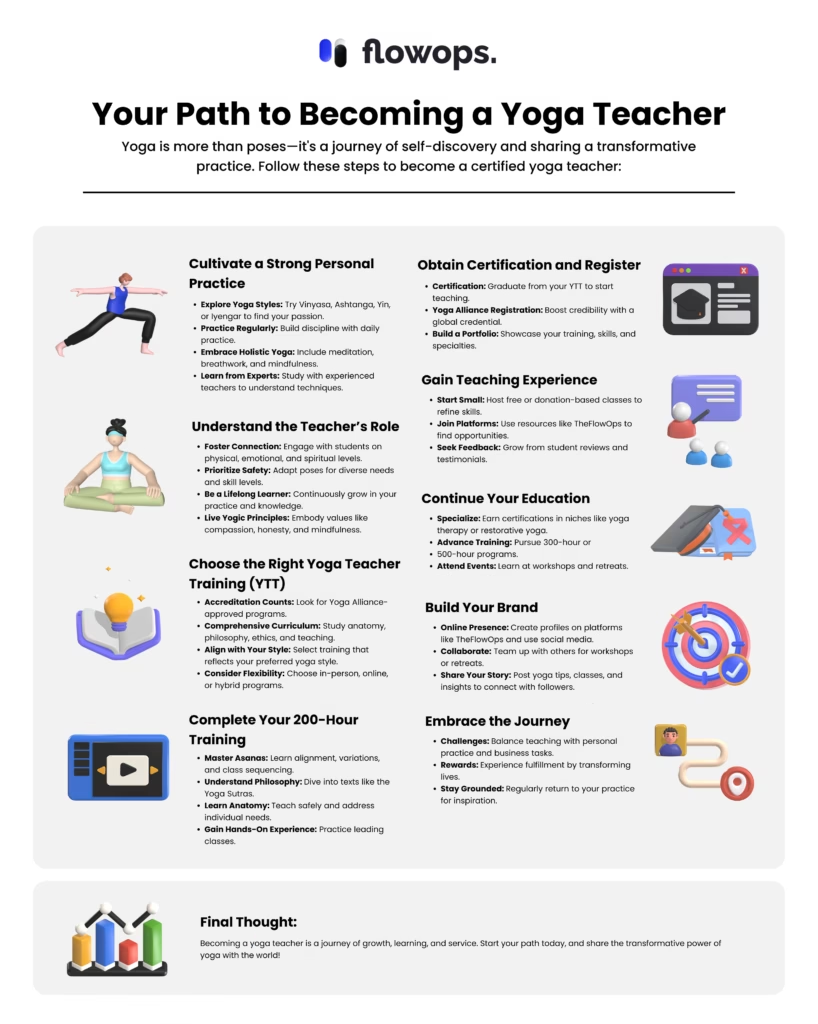Yoga is more than movement—it’s a practice that nourishes the body, calms the mind, and reconnects us with something deeper.
Maybe you started yoga to manage stress, ease physical tension, or simply find a quiet moment in a busy day.
Over time, something shifted.
You found clarity on the mat, a sense of belonging in the breath—and now, you’re feeling the quiet pull to share that experience with others.
If you’ve been wondering what it takes to become a yoga teacher, that curiosity is a beautiful place to start.
Teaching yoga isn’t just about mastering poses or memorizing sequences. It’s about stepping into a role where you guide, hold space, and carry forward a tradition that’s both ancient and deeply personal.
Here’s a step-by-step look at how to begin that journey.
1. Cultivate a Strong Personal Practice
To teach yoga effectively, you must first develop a consistent personal practice. This is where you build your understanding of yoga’s physical, mental, and philosophical elements.
- Dive into Different Styles: Yoga is vast, with styles ranging from Vinyasa and Ashtanga to Yin and Iyengar. Experiment with these styles to discover what resonates with you.
- Consistency is Key: Practicing regularly helps you develop discipline and a deeper connection to the practice. Aim to make yoga a daily ritual.
- Go Beyond Asanas: Yoga isn’t just about poses. Embrace practices like meditation, breathwork (pranayama), and mindfulness to cultivate a holistic understanding.
- Seek Guidance: Attend classes with experienced teachers, study their techniques, and note how they create an engaging, safe, and inclusive environment.
By immersing yourself in yoga, you’ll gain the confidence and authenticity necessary to inspire others.

2. Understand the Role of a Yoga Teacher
Being a yoga teacher goes far beyond demonstrating poses. It’s about holding space for your students, understanding their needs, and guiding them with care and wisdom.
- Foster Connection: As a teacher, you’ll connect with students on a physical, emotional, and sometimes spiritual level.
- Prioritize Safety: Learn how to modify poses for students with injuries, limitations, or varying skill levels.
- Be a Lifelong Student: A great teacher continues to learn and grow, deepening their practice while inspiring their students to do the same.
- Embody Yogic Principles: Beyond the mat, yoga teachers are role models for the principles of yoga, including compassion (ahimsa), honesty (satya), and mindfulness.
Understanding the responsibility of teaching ensures you approach this role with the right mindset.
3. Choose the Right Yoga Teacher Training (YTT) Program

Selecting the right YTT program is a critical step on your journey. With countless options available, it’s essential to choose a program that aligns with your goals and values.
- Accreditation Matters: Ensure the program is accredited by a reputable body like Yoga Alliance, which sets standards for yoga education and makes your certification widely recognized.
- Comprehensive Curriculum: Look for programs that cover key areas: yoga philosophy, anatomy, teaching methodology, ethics, and practice teaching.
- Align with Your Style: If you love Hatha yoga, for instance, choose a training that specializes in it. This alignment will make your learning process more fulfilling.
- Consider the Format: In-person programs offer hands-on experience, while online programs provide flexibility. Some programs blend both for a balanced approach.
- Research Instructors: Learn about the lead trainers. Do they have deep experience and a teaching style that resonates with you?
Choosing a program that fits your needs ensures you start your teaching journey on the right foot.
4. Complete Your 200-Hour Training
The 200-hour Yoga Teacher Training (YTT) is your gateway to becoming a certified yoga teacher. This immersive program equips you with the tools to guide others confidently.
- Asana Mastery: You’ll learn proper alignment, variations, and sequencing of poses to create safe and engaging classes.
- Philosophical Foundations: Delve into ancient texts like the Yoga Sutras and explore the principles that underpin the practice.
- Anatomy and Physiology: Understanding the body’s mechanics ensures you can teach safely and address diverse student needs.
- Practice Teaching: Most programs include peer-teaching opportunities, where you’ll gain hands-on experience leading classes.
- Personal Transformation: Beyond skills, expect personal growth as you immerse yourself in this rigorous yet rewarding experience.
Need help planning your classes? Download the free Yoga Deck, a visual guide to help you design sequences with confidence.
Dedicate yourself to the process, and you’ll emerge not just as a certified teacher but as a more empowered and insightful individual.
5. Obtain Certification and Register as a Yoga Teacher
Once you’ve completed your 200-hour training, you’ll receive a certificate recognizing your achievement. To enhance your credibility, consider registering with a professional body like Yoga Alliance.
- Yoga Alliance Registration: This globally recognized credential demonstrates that you’ve met high standards of yoga education. Registration can boost your professional reputation and may be a prerequisite for teaching at studios or hosting retreats. However, it’s essential to note that registering with Yoga Alliance involves costs: a one-time application fee of $50 and an annual renewal fee of $65. These fees allow you to maintain your profile in their registry and access professional development resources
- Create a Portfolio: Start building your teaching portfolio by documenting your training, skills, and any specialties.
Taking this step formalizes your journey and sets the stage for your teaching career.
6. Gain Teaching Experience
Experience is the bridge between certification and mastery. After completing your training, it’s time to start putting your skills into practice. Whether you’re teaching online or in person, gaining experience will help you refine your teaching style and build confidence.

- Host Free or Donation-Based Classes: Begin by teaching friends, family, or community groups. This allows you to experiment with sequencing, pacing, and your unique teaching approach in a supportive environment.
- Use TheFlowOps to Launch Your Yoga Business: TheFlowOps is an all-in-one platform designed specifically for yoga teachers. You can:
- Create a yoga teacher website with a beautiful, easy-to-use website builder
- Accept payments for classes or private sessions through integrated payments
- Schedule and manage your sessions with a built-in appointment scheduler
- Share your class schedule and availability with students easily—no extra tools required
- Seek Feedback: Always encourage feedback from your students to improve your classes. Platforms like TheFlowOps can also facilitate reviews and testimonials, helping you build credibility.
By leveraging tools like TheFlowOps, you can streamline your entry into the yoga teaching world while connecting with a broader audience.
7. Continue Your Education
Yoga is a lifelong journey, and continuing education ensures you stay inspired and relevant as a yoga teacher.
- Specialized Training: Pursue additional certifications in areas like restorative yoga, yoga therapy, or children’s yoga.
- Workshops and Retreats: Attend events to deepen your practice, connect with peers, and learn from seasoned teachers.
- Advanced Certifications: A 300-hour or 500-hour training can enhance your expertise and open doors to mentoring or leading teacher training.
By investing in your education, you’ll keep evolving both as a teacher and practitioner.
8. Build Your Brand as a Yoga Teacher
In today’s digital-first world, building your personal brand is essential to stand out as a yoga teacher. Your brand communicates who you are, your teaching style, and what students can expect from your classes.
- Showcase Your Expertise on TheFlowOps: Use TheFlowOps to create a professional yoga website that highlights your credentials, specialties, and teaching schedule. With its easy-to-navigate platform, you can connect with students, manage your offerings, and establish a strong presence.
- Leverage Social Media: Pair your profile on TheFlowOps with a consistent presence on social media platforms like Instagram, YouTube, or TikTok. Share snippets of your classes, insights about your yoga journey, and tips for students.
- Collaborate with Others: Collaboration is a powerful way to expand your reach and enrich your teaching practice. Consider teaming up with fellow yoga teachers or wellness professionals to co-teach workshops, host retreats, or create joint offerings.

By integrating tools like TheFlowOps into your branding strategy, you’ll create a seamless and professional way for students to find and connect with you, all while boosting your visibility in the yoga community.
Not sure how to structure your yoga teacher website or class offerings? TheFlowOps offers a library of professional templates to help you get started fast. Whether you need a landing page for a retreat, a bio page, or a scheduler layout, there’s a design to fit your needs—and your brand
9. Embrace the Challenges and Rewards of Teaching
The path of a yoga teacher is both rewarding and demanding.
- Challenges: Balancing the physical demands of teaching with your own practice, managing diverse student needs, and navigating the business side of yoga can be overwhelming.
- Rewards: Witnessing your students’ growth, building meaningful connections, and living your passion make the journey worthwhile.
- Stay Grounded: Regularly return to your own practice to recharge and stay connected to why you began this journey.
You’ll find immense fulfillment in this vocation by embracing the highs and lows.
Ready to Create Your Yoga Website?
Choose from templates made for yoga teachers and launch with tools for scheduling, bookings, and more. Start with a premium trial — and continue on the free plan for as long as you need.
No credit card needed. Cancel anytime.

Final Thoughts
Learning how to become a yoga teacher is more than a checklist; it’s a journey of self-discovery and service. Each step—deepening your practice, undergoing training, gaining experience, and building your brand—brings you closer to sharing the gift of yoga with the world.
Your dedication to this path has the power to transform not only your life but the lives of countless others. So take the leap, and let your journey unfold—one mindful breath at a time.
Ready to take the first step? Get started for free with your own professional yoga teacher website and simplify the business side of your teaching journey.



